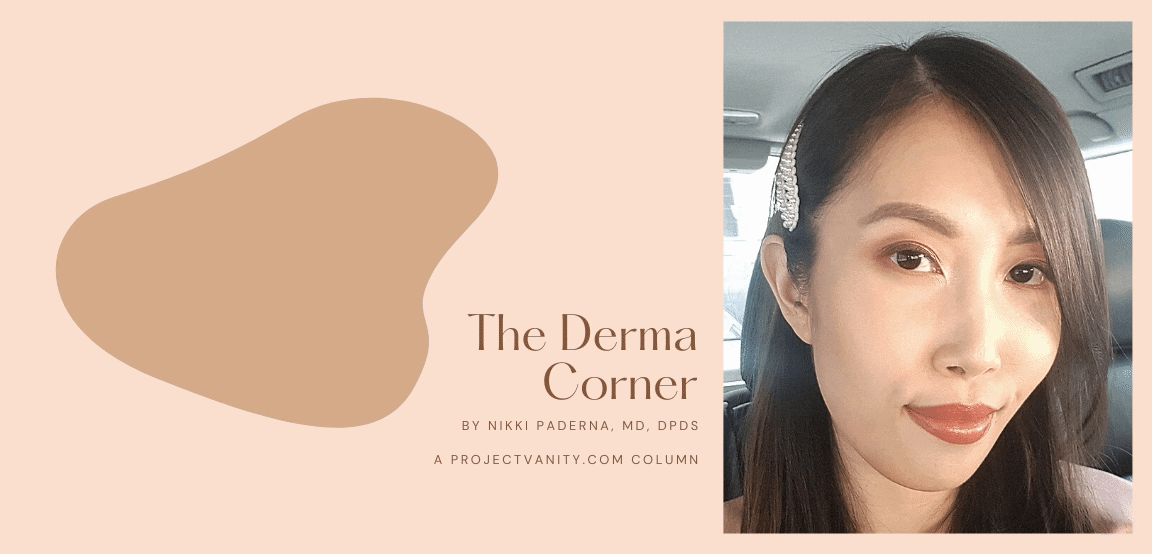The Derma Corner: What to do with hyperpigmentation from acne (or PIH)
We’re happy to introduce our newest columnist, dermatologist Nikki Paderna! She will be answering some of our burning skincare questions, so if you have one, feel free to email it to liz [at] projectvanity.com so we can take a look at it!
I’ve talked about acne last time but now let me discuss one of the two dreaded consequences from having a breakout – post-inflammatory hyperpigmentation or PIH. This happens because any inflammation to the skin (e.g. acne, eczema, irritant/allergic reaction, trauma, etc.) will have inflammatory cells causing a cascade of events that will lead to melanocytes (pigment-producing cells of the skin) to produce more melanin – what’s causing the skin pigmentation.
Now there are a variety of topicals available in the market to lighten up acne marks. It could be confusing to a skincare newbie so let me mention which ingredients are a favorite of mine that I use in practice and personally for PIH.
Vitamin C is a very potent antioxidant with anti-aging effects that inhibits further melanin production. It also has a potential anti-inflammatory effect on acne, helps promote wound healing and prevents PIH.
Topical retinoids are effective against PIH whether by itself or with the combination of other depigmenting products. They help speed up cell turnover, which will reduce melanin over time helping to brighten up dark marks. It can further reduce inflammation which is helpful in cases of inflammatory acne.
Hydroxy acids (salicylic acid, glycolic acid, etc.) helps treat and reduce hyperpigmentation by sloughing off dead skin cells. However, not all kinds will be suitable to every skin type. Sensitive skins might find lactic acid less irritating than glycolic acid while dry skin types will benefit more from glycolic acid since it’s also a humectant (pulls moisture from the air in a humid environment).
Niacinamide, the active form of niacin (vitamin B3), has been shown in clinical trials to reduce hyperpigmentation by preventing the deposition of melanin in the skin. For oily and acne-prone skins, it reduces the skin’s oil production and refines pores.
Azelaic acid has several ways of reducing skin pigmentation by preventing production of melanin. It’s effective against both inflammatory and non-inflammatory acne because of its antibacterial effect and it acts kind of like a topical retinoid in that it normalizes the skin cells in a hair follicle, preventing comedone formation.
Sunscreen is not an ingredient but it’s an essential step in treating hyperpigmentation because it prevents PIH from worsening. The UV radiation from the sun can actually increase the inflammation and redness brought about by acne, thereby increasing melanin production which leads to hyperpigmentation.
Other ingredients that may interest you with brightening effects include antioxidants like vitamin E (or alpha tocopherol), kojic acid, and arbutin. There’s also licorice extract, which contains glabridin, a flavonoid with an anti-inflammatory effect that prevents pigmentation caused by UVB rays, and tranexamic acid which prevents the interaction of UV radiation with melanocytes.
Aside from these cosmeceuticals I mentioned, there are other options worth noting like using hydroquinone, having chemical peels, dermabrasion, microdermabrasion, IPL therapy and laser procedures. However, all of these should be under close medical supervision by a dermatologist because of their side effects.
Before I end this article, here are some things to remember the most.
The earlier the cause of inflammation is treated – acne in this case, the faster the hyperpigmentation will be resolved.
Just because these are proven to reduce skin pigmentation doesn’t mean that they cannot be the cause. In fact, any of them can cause PIH when they irritate the skin.
Be patient since it may take weeks or even longer for any of these to work.
Lastly, don’t pick on your pimples. I know there’s nothing more satisfying than seeing gunk come out of a freshly squeezed pimple but the more you pick on them, the more inflammation there will be. So the next time you’re tempted to squeeze a pimple, don’t. Just think of how dark it will be after.
Until my next article, stay safe everyone!
Dr. Nikki Paderna is currently available for online consultations thru the HealthNow app on Google Play for Android devices and on the Apple store for iOS devices, or thru the FB page, Vivestrata Dermatology Clinic.



